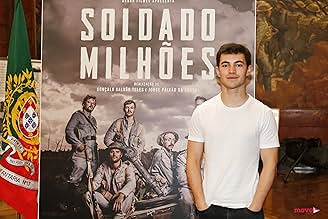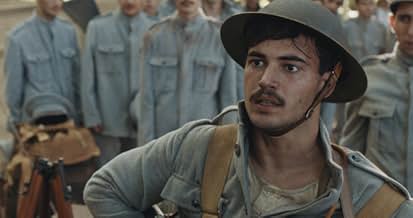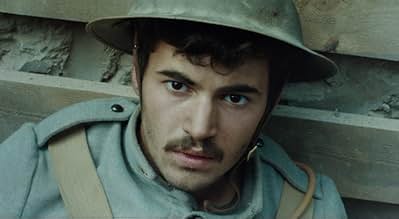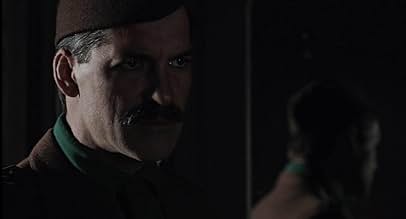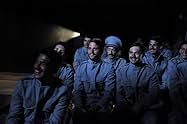IMDb RATING
6.3/10
863
YOUR RATING
A Portuguese soldier who got stranded from his team during the La Lys battle struggles alone through dozens of German offensives so he can guarantee his companions' safety.A Portuguese soldier who got stranded from his team during the La Lys battle struggles alone through dozens of German offensives so he can guarantee his companions' safety.A Portuguese soldier who got stranded from his team during the La Lys battle struggles alone through dozens of German offensives so he can guarantee his companions' safety.
- Directors
- Writers
- Stars
- Awards
- 5 wins & 10 nominations total
- Directors
- Writers
- All cast & crew
- Production, box office & more at IMDbPro
Featured reviews
Although i do believe this film could have been made better.. the story behind this film is special. With there not being many if any films of the Portuguese during the great war (1914-18), I think this film depicts amazingly the story of Anibal Milhais (The Protagonist) who is the most decorated Portuguese soldier of all time. Moreover, as a Portuguese person myself, this film has a special place in my heart, as it accurately shows the horrors of war. I think it is worth a watch although it is no 10/10 film it is still a very good film especially for WW1 enthusiasts who love to learn about the Great War and those who didn't know Portugal was involved.
Did a bad review about this movie, a couple of months ago, but I've gave it another try... Things changed a bit... I saw it with another eyes, and the second time around, I enjoy it a bit more.
There's, still, so little action here... I would love to see more battle scenes (there's few WWI movies)..., unfortunately, portuguese are, still, a bit slow on movie writing... Still the movie deserves the 2nd view... But I'm proud for sharing the same country as this hero, Soldado Milhões... Too bad the movie didn't tell all the story, and showed that the british were cowards, and left behind a group of farmers, with almost no fighting experience... Still, we showed our gut, and our courage, and that's way more than they did...
There's, still, so little action here... I would love to see more battle scenes (there's few WWI movies)..., unfortunately, portuguese are, still, a bit slow on movie writing... Still the movie deserves the 2nd view... But I'm proud for sharing the same country as this hero, Soldado Milhões... Too bad the movie didn't tell all the story, and showed that the british were cowards, and left behind a group of farmers, with almost no fighting experience... Still, we showed our gut, and our courage, and that's way more than they did...
"Tu és Milhais mas vales milhões" (Your name is Milhais but you are worth millions). This was what the commander of the platoon to which the soldier Milhais belonged told him when he rejoined his group after having remained behind in their trench to fight alone a large number of German soldiers who were assaulting his trench thus protecting the retreat of his comrades. He went from one machine gun to another making the enemy to believe that there were several soldiers fighting them and not only one. He was successful and got the highest miltary insígnia given to a private in Portugal. And he kept that second name forever. It was even added to his village name This was actually true and and occurred in Flanders where Portiguese troops fought the German along with the Allies particularly in the La Lys battle in WWI. All the actors do an excellent job and the movie is technically very good namely by crossing the battle scenes with some later scenes when Milhões was already in his village trying to hunt a wolf and keeping a tender relationship with his little daugher Adelaide. The whole movie atmosphere is very realistic.
The Great War (1914-1918), or First World War, shattered Europe, and there is hardly a European today with ancestors that did not fight in it, or were at the very least affected by it. I knew nothing of the Portuguese army and its involvement in the war until I came across this film, so it was an education for me. It is a home-grown film about one soldier in particular, who is the only soldier to ever be awarded Portugal's highest decoration for bravery, for his actions on the Western Front in the spring of 1918. His story is told through flashbacks, from his arrival in France in the 1917 with the Portuguese Expeditionary Force, while in the present-day in 1943, he hunts a wolf in the countryside near his farm, with his young daughter.
The English title I watched this under was "Courage of One". The war scenes first. They are very well-shot, and the attention to detail in the uniforms and the trench warfare, and action, is decent. I have to admit that the Lewis gun was distracting to me, as a history buff, because the magazine often rotates around even when Milhais is not pulling the trigger. An interesting prop malfunction. But that can be overlooked. As can the clear fact that the film was shot in Portugal, and not in northern France or Belgium. I had unnerving flashbacks to the 1960s film "Battle of the Bulge", set in the Ardennes in the winter of 1944, but filmed in Spain. However, "Courage of One" gets away with it, as the action is set in the spring.
The narrative works very well, and is the film's strong-point. The present-day adventure of Milhais hunting the wolf runs parallel to the narrative of the Great War. Carminho Coelho plays the role of his daughter, and she is excellent, and contributes to some of the best scenes in the film, as I found it to be a very strong and moving portrayal of a father and daughter relationship. "I've read your service records ten times," she tells her father, after she recites some war facts about him, when he joined the army and when he arrived in France. Overall, I highly recommend "Courage of One" to history fans. The crew did a fine job here with their low-budget. They substituted France and Flanders for the Portuguese countryside without making a complete mess of it, but it is the narrative that seals victory and makes this a film worth seeking out.
The English title I watched this under was "Courage of One". The war scenes first. They are very well-shot, and the attention to detail in the uniforms and the trench warfare, and action, is decent. I have to admit that the Lewis gun was distracting to me, as a history buff, because the magazine often rotates around even when Milhais is not pulling the trigger. An interesting prop malfunction. But that can be overlooked. As can the clear fact that the film was shot in Portugal, and not in northern France or Belgium. I had unnerving flashbacks to the 1960s film "Battle of the Bulge", set in the Ardennes in the winter of 1944, but filmed in Spain. However, "Courage of One" gets away with it, as the action is set in the spring.
The narrative works very well, and is the film's strong-point. The present-day adventure of Milhais hunting the wolf runs parallel to the narrative of the Great War. Carminho Coelho plays the role of his daughter, and she is excellent, and contributes to some of the best scenes in the film, as I found it to be a very strong and moving portrayal of a father and daughter relationship. "I've read your service records ten times," she tells her father, after she recites some war facts about him, when he joined the army and when he arrived in France. Overall, I highly recommend "Courage of One" to history fans. The crew did a fine job here with their low-budget. They substituted France and Flanders for the Portuguese countryside without making a complete mess of it, but it is the narrative that seals victory and makes this a film worth seeking out.
I actually quite enjoyed the story behind this film. However, the inaccurate depiction of use of the Lewis Gun totally spoiled it for me, and I got increasingly frustrated towards the end of the film, as Milhais continued to fire Lewis guns for long periods without ever reloading.
The Lewis was a light machine gun, intended to be fired in bursts. It fires at a rate of 500 rounds per minute. The pan magazines hold 47 or 97 rounds, so even using the larger magazine, firing the gun constantly empties the magazine in just over 10 seconds. In normal use, Lewis gunners were accompanied by a loader, who changed the magazines, and several others who carried the large number of magazines necessary to keep up a high rate of fire. However Milhais is shown firing the Lewis as if it were a belt-fed machine gun, without it ever being reloaded, and with no spare magazines in sight. This lack of authenticity completely ruined the film for me.
The Lewis was a light machine gun, intended to be fired in bursts. It fires at a rate of 500 rounds per minute. The pan magazines hold 47 or 97 rounds, so even using the larger magazine, firing the gun constantly empties the magazine in just over 10 seconds. In normal use, Lewis gunners were accompanied by a loader, who changed the magazines, and several others who carried the large number of magazines necessary to keep up a high rate of fire. However Milhais is shown firing the Lewis as if it were a belt-fed machine gun, without it ever being reloaded, and with no spare magazines in sight. This lack of authenticity completely ruined the film for me.
Did you know
- GoofsThough the film states that the village where Milhais is from changed its name in 1943, in fact Valongo changed its name to Valongo de Milhais long before, in 1924.
Details
- Release date
- Country of origin
- Language
- Also known as
- Hero on the Front
- Production companies
- See more company credits at IMDbPro
Box office
- Budget
- €910,000 (estimated)
- Gross worldwide
- $139,271
- Runtime
- 1h 25m(85 min)
- Color
- Aspect ratio
- 2.39 : 1
Contribute to this page
Suggest an edit or add missing content



